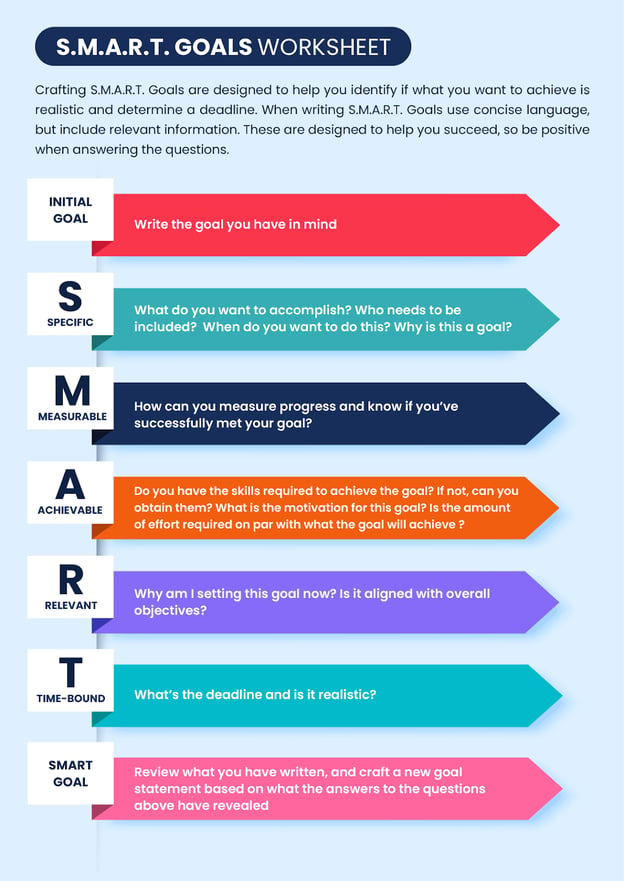Unlock the secret to success with these 5 essential strategies for setting smart and effective professional development goals.
Table of Contents
Introduction: Why Set Professional Development Goals?
We will start by explaining what professional development goals are and why they are important for growing in your job or learning new things. Setting smart goals for professional development can help you improve your skills, advance in your career, and achieve personal growth goals.
Personal professional development is all about setting targets for yourself to work towards. It could be learning a new skill, taking on more responsibility at work, or even changing careers. By having clear goals in mind, you can stay focused and motivated to keep moving forward.
Understanding SMART Goals
Setting goals is important for personal development and professional growth. But not all goals are created equal. This section will explain the SMART acronym and how it applies to setting effective goals for professional growth.
What Does SMART Stand For?
The SMART acronym stands for Specific, Measurable, Achievable, Relevant, and Time-Bound. Let’s break down what each of these components means:
- Specific: Your goal should be clear and well-defined. Instead of saying “I want to get better at my job,” a specific goal would be “I want to improve my public speaking skills by taking a course.”
- Measurable: You should be able to track your progress and know when you have achieved your goal. For example, you can measure your progress in the public speaking course by tracking how many speeches you give and how confident you feel.
- Achievable: Your goal should be realistic and within reach. Setting a goal to become the CEO of your company in a year may not be achievable, but setting a goal to get a promotion within the next two years could be more realistic.
- Relevant: Your goal should be meaningful and relevant to your career or personal development. Make sure it aligns with your values and long-term objectives.
- Time-Bound: Set a deadline for when you want to achieve your goal. This creates a sense of urgency and helps you stay focused.
Examples of SMART Goals
Here are a few examples of what a SMART goal for professional development might look like:
- Specific: “I will complete a leadership training program within the next six months.”
- Measurable: “I will increase my sales by 10% in the next quarter.”
- Achievable: “I will earn a certification in project management within the next year.”
- Relevant: “I will improve my technical skills to align with the changing demands of my industry.”
- Time-Bound: “I will develop a new marketing campaign by the end of this month.”
Key #1: Specific Goals
When it comes to setting professional development goals, one of the most important keys is to be specific about what you want to achieve. Being clear and precise about your goals will help you stay focused and motivated throughout your journey of personal growth.

Image courtesy of startupgeek.com via Google Images
How to Make Your Goals Specific
Here are some tips on how to make your goals as specific as possible:
1. Clearly define what you want to accomplish. Instead of saying, “I want to improve my skills,” specify exactly which skills you want to improve and why.
2. Make sure your goals are measurable. This means you should be able to track your progress and know when you have successfully achieved your goal.
3. Set a deadline for achieving your goal. Having a specific timeframe will help you stay on track and hold yourself accountable.
By setting specific goals, you will have a clear roadmap towards your personal and professional development. Remember, the more detailed and precise your goals are, the easier it will be to work towards them effectively.
Key #2: Measurable Goals
In this part, we’ll discuss how to make sure you can tell when you have reached your goals.
Setting Milestones
We’ll explain what milestones are and how they can help you keep track of your progress. Milestones are like checkpoints along the way to your final goal. They help you see how far you’ve come and how much further you have to go. For example, if your goal is to read ten books in a month, you can set a milestone to finish two books every week. This way, you can measure your progress and adjust your efforts if needed.
Achievable Goals
In order to make progress and feel successful in your personal and professional development, it’s crucial to set goals that are achievable. This means that the goals you set should be realistic and within reach based on your current skills, resources, and circumstances. Let’s dive into why achievable goals are so important.

Image courtesy of www.indeed.com via Google Images
Realistic Goal-Setting
Setting achievable goals means taking a good look at what you are capable of achieving. It’s like setting yourself up for success by making sure your goals are not too easy or too hard. Think about what skills you already have and what resources you have access to that can help you reach your goals.
For example, if you’re trying to learn a new skill, make sure you have the time and resources to dedicate to practicing and improving. Setting a goal to become an expert in something overnight might not be achievable, but setting smaller goals to learn and practice regularly can lead to steady progress.
Key #4: Relevant Goals
When it comes to setting professional development goals, it’s crucial to ensure that they are relevant to your career or personal learning. In this section, we will delve into why setting relevant goals is key to your growth.
Aligning Goals with Your Career
It’s essential to choose goals that align with your current job or the job you aspire to have in the future. By setting goals that are relevant to your career path, you are more likely to stay motivated and focused on achieving them.
| Key | Description |
|---|---|
| 1 | Set Specific Goals |
| 2 | Make Goals Measurable |
| 3 | Align Goals with Career Objectives |
| 4 | Establish Realistic Timelines |
| 5 | Regularly Review and Update Goals |
For example, if you are working in marketing and your goal is to improve your social media skills, this would be directly relevant to your current role. On the other hand, setting a goal to learn how to code may not align as closely with your career unless you are looking to transition into a tech-related role.
Key #5: Time-Bound Goals
Setting deadlines for your goals is like giving yourself a finish line to aim for. Just like in a race, knowing when you need to reach the end keeps you moving forward. When you set a time limit for your goals, you can track your progress and stay motivated to keep working.

Image courtesy of ideas.baudville.com via Google Images
For example, if your goal is to finish reading a certain number of books to improve your knowledge in a particular area, you could set a deadline to finish one book every month. This way, you have a clear timeline to follow, and you can adjust your reading pace accordingly to meet your goal.
Time-bound goals also help you prioritize your tasks. When you know you have a deadline approaching, you are more likely to focus on the activities that will help you achieve your goal instead of getting sidetracked.
Bringing It All Together: My Personal Development Plan
In order to create a successful personal development plan, it is important to combine all the key elements we have discussed. By incorporating specific, measurable, achievable, relevant, and time-bound goals, you can effectively chart a path towards personal growth and professional success.
Setting Specific Goals
To start, make sure your goals are crystal clear. Clearly define what you want to achieve in your personal and professional life. This will give you a clear target to aim for and keep you focused on your objectives.
Measuring Your Progress
Tracking your progress is essential in ensuring that you are on the right path towards achieving your goals. Set milestones along the way to monitor your advancement and celebrate your successes as you move forward.
Achieving Realistic Goals
It is crucial to set goals that are challenging yet attainable. Be sure to match your goals with your abilities and resources to increase the likelihood of success. Remember, it’s okay to adjust your goals if needed to stay on track.
Aligning Goals with Your Career
Your goals should align with your career aspirations and personal interests. Choose objectives that will help you grow in your current role or prepare you for future opportunities. By ensuring your goals are relevant to your professional development, you can stay motivated and engaged in your journey.
Creating a Timeline
Setting deadlines for your goals is essential for maintaining focus and accountability. Establishing a timeline will help you prioritize tasks, allocate resources efficiently, and track your progress over time. Remember, deadlines are meant to keep you on track, not to add unnecessary pressure.
By incorporating these key elements into your personal development plan, you can create a roadmap for success and continuous growth. Remember, personal development is an ongoing process, so be flexible, stay committed, and celebrate your achievements along the way.
Frequently Asked Questions (FAQs)
We will answer some common questions about setting professional development goals.
What if I don’t reach my goal by the deadline?
If you find yourself in a situation where you haven’t reached your goal by the deadline you set, don’t worry! It’s okay if things don’t always go as planned. Take a moment to reflect on why you didn’t achieve your goal. Was it because the goal was too ambitious? Were there unexpected challenges that came up along the way? Use this as a learning opportunity to adjust your approach and set a new timeline that is more realistic. Remember, setbacks are a natural part of the growth process, and it’s essential to stay positive and motivated to keep moving forward.
How often should I review my development goals?
It’s crucial to regularly review your development goals to ensure you are making progress and staying on track. A good practice is to schedule regular check-ins with yourself, whether it’s weekly, monthly, or quarterly, to assess how you are doing. During these reviews, take the time to reflect on your accomplishments, identify any obstacles or challenges you’ve encountered, and adjust your goals if necessary. By consistently revisiting your goals, you can stay focused, motivated, and accountable for your growth and development.


Leave a Reply